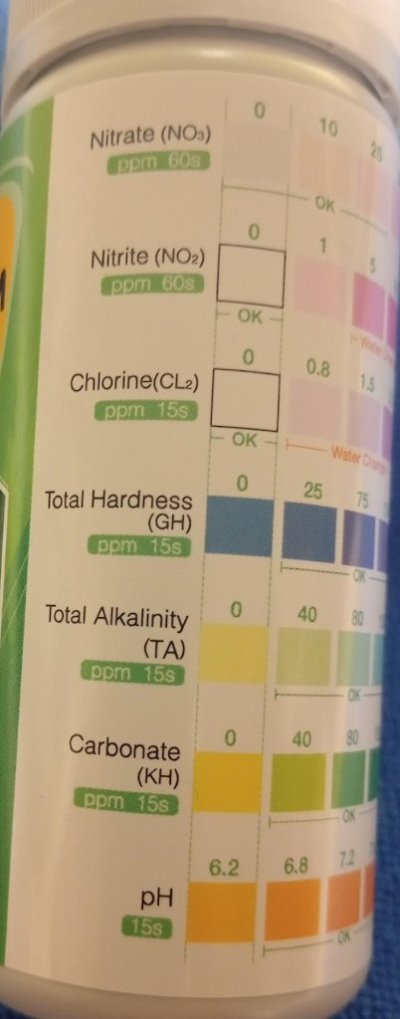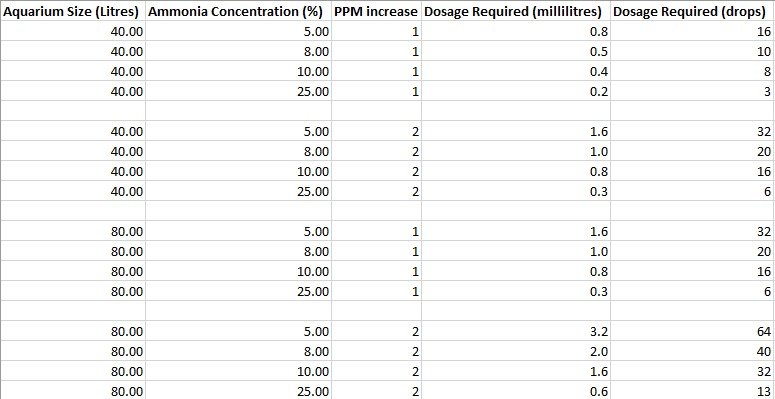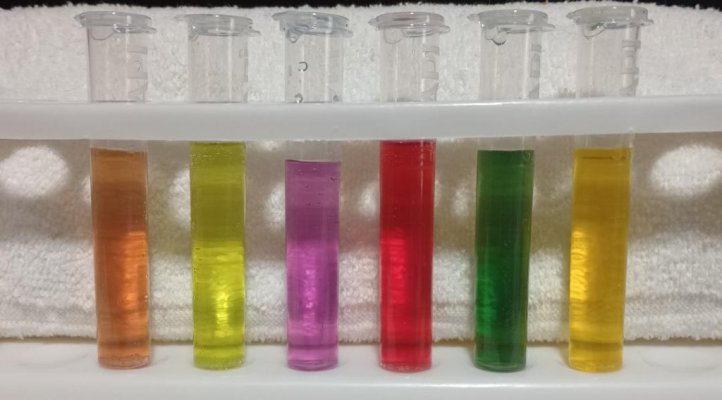I keep seeing seeing what different things need to be at ppm in my tank. I know it means parts per million. For example, if I need to add ammonia to my 10 gallon tank to raise it from 2 to 4 ppm while cycling, how much do I add ? How do I figure out how much a ppm is ? My tank has been set up since 2 - 27 -24, starter dose of 5cc Seachem Stability then 2 1/2 cc for 7 days. 3 drops of ammonia every other day. I tested everything yesterday with the API liquid tests. nitrate 160, nitrite 5.0, ammonia 0, pH between 7.6 and 8.0 . Do I leave it alone for a couple of days to see if the nitrate and nitrite levels start to come back down, or do I need to add more ammonia and how much ? The add x amount ppm is what I don't know how to figure out. I need it say something like.....if ammonia is at 2.0, add 6 drops of ammonia to bring it to 4.0 in a 10 gallon tank. Sorry, I'm really math stupid.Also in the attached pic, what does ppm 60s and ppm 15s mean on these test strips ? Using these, the nitrate was 250, nitrite 10, and pH 8.0
You are using an out of date browser. It may not display this or other websites correctly.
You should upgrade or use an alternative browser.
You should upgrade or use an alternative browser.
Need ppm help.
- Thread starter Kimbo57
- Start date
The friendliest place on the web for anyone with an interest in aquariums or fish keeping!
If you have answers, please help by responding to the unanswered posts.
If you have answers, please help by responding to the unanswered posts.
As you say ppm is parts per million. So if you have 1 litre of water, to add 1 ppm you need to add 1 millionth of a litre. So that is 0.1 millilitres.
How much ammonia to add to your tank to raise level by 1ppm is impossible to say as i have no idea how concentrated your ammonia is.
Do you know what ammonia you are using? Is it a bleech product or an ammonium chloride product like Dr Tims?
Test daily, every time your ammonia drops below 2ppm redose ammonia to 2ppm. When you are able to add 2ppm of ammonia to your tank and 24 hours later see zero ammonia and zero nitrite you are cycled.
Nitrate will never drop except when you do a water change. Thats not how the cycle works. Nitrate is the what you get at the end.
The 15s, 60s is how long in seconds after you have dipped the strip in the water you should read the relevant test. Eg the pH should be read after 15 seconds, the nitrate after 60 seconds. Test strips are notoriously unreliable. Get a liquid test kit like API freshwater master testkit. You simply cant trust anything a test strip tells you.
How much ammonia to add to your tank to raise level by 1ppm is impossible to say as i have no idea how concentrated your ammonia is.
Do you know what ammonia you are using? Is it a bleech product or an ammonium chloride product like Dr Tims?
Test daily, every time your ammonia drops below 2ppm redose ammonia to 2ppm. When you are able to add 2ppm of ammonia to your tank and 24 hours later see zero ammonia and zero nitrite you are cycled.
Nitrate will never drop except when you do a water change. Thats not how the cycle works. Nitrate is the what you get at the end.
The 15s, 60s is how long in seconds after you have dipped the strip in the water you should read the relevant test. Eg the pH should be read after 15 seconds, the nitrate after 60 seconds. Test strips are notoriously unreliable. Get a liquid test kit like API freshwater master testkit. You simply cant trust anything a test strip tells you.
I'm using regular clear household ammonia. I add 2 drops per gallon/1cc in the 10 gallon tank and 2 cc in the 20 gallon tank. I do have the API master fresh water test kit and I put the results from yesterday in the post above. Since the nitrate and nitrite is high, should I do a 25 % water change now ? I only used the strips because they came with the 20 gallon tank I bought used.As you say ppm is parts per million. So if you have 1 litre of water, to add 1 ppm you need to add 1 millionth of a litre. So that is 0.1 millilitres.
How much ammonia to add to your tank to raise level by 1ppm is impossible to say as i have no idea how concentrated your ammonia is.
Do you know what ammonia you are using? Is it a bleech product or an ammonium chloride product like Dr Tims?
Test daily, every time your ammonia drops below 2ppm redose ammonia to 2ppm. When you are able to add 2ppm of ammonia to your tank and 24 hours later see zero ammonia and zero nitrite you are cycled.
Nitrate will never drop except when you do a water change. Thats not how the cycle works. Nitrate is the what you get at the end.
The 15s, 60s is how long in seconds after you have dipped the strip in the water you should read the relevant test. Eg the pH should be read after 15 seconds, the nitrate after 60 seconds. Test strips are notoriously unreliable. Get a liquid test kit like API freshwater master testkit. You simply cant trust anything a test strip tells you.
Household ammonia can be anything from a 5% solution to an 10% solution. Commercial ammonia can be up to a 25% solution. So nobody can tell you how much to add because they dont know the concentration of your specific household product.
If we assume your household ammonia is 10% then your 1cc in 10 gallons/ 40 litres would raise ammonia by 2.5ppm. 2cc in 20 gallons/ 80 litres would raise ammonia by the same 2.5ppm. So what you are adding seems to be about right. You dont need to be bang on, somewhere in the region of 2ppm is fine. (I'll check my maths when i can get to a pen and paper though).
What does adding your 1cc/ 2cc raise the ammonia by through testing? If it raises it by about 2ppm, then its fine.
You dont have fish in the tank, so it doesnt matter that nitrite and nitrate are high. You can change some water before you redose ammonia or not. It doesnt really matter, but a water change will replenish some carbonate hardness which might help.
If we assume your household ammonia is 10% then your 1cc in 10 gallons/ 40 litres would raise ammonia by 2.5ppm. 2cc in 20 gallons/ 80 litres would raise ammonia by the same 2.5ppm. So what you are adding seems to be about right. You dont need to be bang on, somewhere in the region of 2ppm is fine. (I'll check my maths when i can get to a pen and paper though).
What does adding your 1cc/ 2cc raise the ammonia by through testing? If it raises it by about 2ppm, then its fine.
You dont have fish in the tank, so it doesnt matter that nitrite and nitrate are high. You can change some water before you redose ammonia or not. It doesnt really matter, but a water change will replenish some carbonate hardness which might help.
Last edited:
There's no info on the ammonia bottle for what percent ammonia it is, just clear household ammonia. I had a hard time finding it because most everything else had soap or fragrance added. I know you said you don't like test strips, but a strip dipped directly in the bottle immediately turned a lot darker blue that the DANGER color blue on the test strip results color.Household ammonia can be anything from a 5% solution to an 10% solution. Commercial ammonia can be up to a 25% solution. So nobody can tell you how much to add because they dont know the concentration of your specific household product.
If we assume your household ammonia is 10% then your 1cc in 10 gallons/ 40 litres would raise ammonia by 2.5ppm. 2cc in 20 gallons/ 80 litres would raise ammonia by the same 2.5ppm. So what you are adding seems to be about right. You dont need to be bang on, somewhere in the region of 2ppm is fine. (I'll check my maths when i can get to a pen and paper though).
What does adding your 1cc/ 2cc raise the ammonia by through testing? If it raises it by about 2ppm, then its fine.
You dont have fish in the tank, so it doesnt matter that nitrite and nitrate are high. You can change some water before you redose ammonia or not. It doesnt really matter, but a water change will replenish some carbonate hardness which might help.
Andy Sager
Aquarium Advice Addict
Here's what you can do: take a gallon of water and start adding your ammonia in measured amounts until you see how much it takes to get to your desired level. Once you know that, you can multiply that number by the number of actual gallons of water in your tank. Remember that tank sizes are not the actual amount of water that is going to be in your tank. Things like substrate and decorations take up space so they reduce the amount of water in the tank.There's no info on the ammonia bottle for what percent ammonia it is, just clear household ammonia. I had a hard time finding it because most everything else had soap or fragrance added. I know you said you don't like test strips, but a strip dipped directly in the bottle immediately turned a lot darker blue that the DANGER color blue on the test strip results color.
Add another 2ppm of ammonia and see what it is tomorrow.
On 3 - 14 I did a 25 % water change. API drops test showed what you see in the pic. From left to right : Ph 7.8, Ammonia 0, Nitrite 1.0, Nitrate 80, GH 15 drops 214.8, KH 8 drops 143.2 Adding ammonia doesn't seem to help. I'm at a loss as what to do now. I also thought the Seachem Aqua Essential was supposed to help with the high numbers. Should I drain the tank and start over or what ?Add another 2ppm of ammonia and see what it is tomorrow.
Add another 2ppm of ammonia and see what it is tomorrow.
Attachments
I dont think you understand what is going on. What you are seeing is whats supposed to happen.
You are trying to grow microbes that feed on ammonia and nitrite. The ammonia you are dosing is food for those microbes. If you feed the microbes they will grow, if you don't feed the microbes they will die. By adding ammonia every day those microbes will grow, and eventually you will have grown enough microbes to be considered cycled. This can easily be a couple of months from beginning to end.
Test your water every day. If your ammonia is below 1ppm, redose enough ammonia to get the ammonia back to 2ppm. When you can add 2ppm of ammonia, and your test 24 hours later shows zero ammonia and nitrite you are cycled.
You arent there yet. You are still seeing nitrite in your testing. You havent grown enough microbes yet. You need keep going with the daily testing and redosing ammonia.
Aqua essential is a water conditioner. It temporarily detoxifies ammonia (and maybe nitrite and nitrate too). It does nothing to help with the cycling, thats not even a claim it makes. It doesnt remove any ammonia, nitrite or nitrate. Its still there, just in a non toxic form. If it did remove ammonia, thats the last thing you want. Remember above. The ammonia is needed to feed those microbes so they can grow. If you remove the ammonia by adding ammonia removing chemicals, ammonia removing filter media or water changes those microbes will die due to lack of food. You want those microbes to be consuming the ammonia.
So from where you are now, add 2ppm ammonia and report back what your test result is 24 hours later. This reporting needs to be done on a daily basis. Reporting back after a week isnt telling us much.
You are trying to grow microbes that feed on ammonia and nitrite. The ammonia you are dosing is food for those microbes. If you feed the microbes they will grow, if you don't feed the microbes they will die. By adding ammonia every day those microbes will grow, and eventually you will have grown enough microbes to be considered cycled. This can easily be a couple of months from beginning to end.
Test your water every day. If your ammonia is below 1ppm, redose enough ammonia to get the ammonia back to 2ppm. When you can add 2ppm of ammonia, and your test 24 hours later shows zero ammonia and nitrite you are cycled.
You arent there yet. You are still seeing nitrite in your testing. You havent grown enough microbes yet. You need keep going with the daily testing and redosing ammonia.
Aqua essential is a water conditioner. It temporarily detoxifies ammonia (and maybe nitrite and nitrate too). It does nothing to help with the cycling, thats not even a claim it makes. It doesnt remove any ammonia, nitrite or nitrate. Its still there, just in a non toxic form. If it did remove ammonia, thats the last thing you want. Remember above. The ammonia is needed to feed those microbes so they can grow. If you remove the ammonia by adding ammonia removing chemicals, ammonia removing filter media or water changes those microbes will die due to lack of food. You want those microbes to be consuming the ammonia.
So from where you are now, add 2ppm ammonia and report back what your test result is 24 hours later. This reporting needs to be done on a daily basis. Reporting back after a week isnt telling us much.
Last edited:
Maybe if you could explain what you think should be happening I could better explain whats going on.
Similar threads
- Replies
- 8
- Views
- 738
- Replies
- 5
- Views
- 1K
- Replies
- 8
- Views
- 581
- Replies
- 2
- Views
- 425
- Replies
- 21
- Views
- 976



